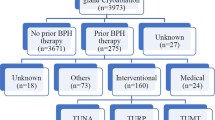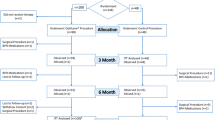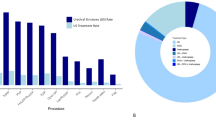Abstract
In this study we analyzed the individual value of baseline parameters to predict the outcome of high energy transurethral microwave thermotherapy in the treatment of patients with lower urinary tract symptoms and benign prostatic hyperplasia.
Two hundred and forty-seven patients with symptomatic benign prostatic hyperplasia were treated with high energy microwave thermotherapy using the software 2.5 (Prostatron). Mean age at the time of treatment was 66.3 (s.d. 8.2) y, the mean prostate volume 57.0 (s.d. 25.2) cc and the mean energy applied was 159 (s.d. 40) KJ. Multi variable analysis on baseline parameters was performed to evaluate their predictive value for response using the WHO-response evaluation criteria for IPSS, maximum flow and urodynamic obstruction (linPURR).
At 1 y follow-up a 57% increase in maximum flow and a 59% decrease in symptom score was noticed following high energy transurethral thermotherapy. The percentage of good responders varies between 12% and 34% depending on the stratification (IPSS, Qmax and linPURR), the percentage of intermediate responders in these categories varies between 17% and 60% and the percentage of poor responders varies between 20% and 49%. Independently predictive baseline parameters for poor response were patients' age, prostate size and grade of bladder outlet obstruction (BOO). The total amount of energy delivered during treatment is also correlated with response.
For the case selection for high energy transurethral microwave thermotherapy three baseline parameters can be identified which predict response for at least one response evaluation criterium: age, prostate size, grade of bladder outlet obstruction (BOO) and total amount of TUMT-energy. Especially the total amount of TUMT-energy is strongly predictive for all three response evaluation criteria, which suggests an important contribution of other mechanisms such as vascularisation and tissue composition to the outcome of high energy TUMT treatment.
This is a preview of subscription content, access via your institution
Access options
Subscribe to this journal
Receive 4 print issues and online access
$259.00 per year
only $64.75 per issue
Buy this article
- Purchase on SpringerLink
- Instant access to full article PDF
Prices may be subject to local taxes which are calculated during checkout
Similar content being viewed by others
Author information
Authors and Affiliations
Rights and permissions
About this article
Cite this article
d’Ancona, F., Francisca, E., Hendriks, J. et al. High energy transurethral thermotherapy in the treatment of benign prostatic hyperplasia: criteria to predict treatment outcome. Prostate Cancer Prostatic Dis 2, 98–105 (1999). https://doi.org/10.1038/sj.pcan.4500293
Received:
Revised:
Accepted:
Published:
Issue date:
DOI: https://doi.org/10.1038/sj.pcan.4500293
Keywords
This article is cited by
-
Therapie des benignen Prostatasyndroms (BPS)
Der Urologe (2009)



